Kitesurfing Wind Forecast: Key Insights for Riders
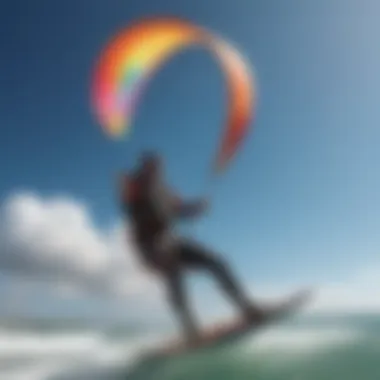

Intro
Kitesurfing relies heavily on one crucial element: the wind. Understanding how to interpret wind forecasts can separate an average day on the water from an unforgettable one. It’s the difference between riding the waves with thrilling acceleration or being stuck on the shore, watching nature play its game. This guide aims to offer insights into kitesurf wind forecasting, breaking down complex concepts into more manageable parts so that every enthusiast, from newbies to seasoned pros, can confidently navigate their next adventure.
The interplay between wind patterns and kitesurfing isn’t merely academic. It shapes every aspect of the ride—the height of jumps, the speed on the water, and the overall enjoyment of the sport. With the right knowledge, you’ll not only maximize your fun but also ensure your safety.
The Importance of Wind in Kitesurfing
Experiencing the rush of gliding over the water is exhilarating, but it’s not without its risks. Wind conditions can change in the blink of an eye, turning a pleasant day into a challenging situation. Being informed about these changes is fundamental for anyone in this sport.
What This Guide Covers
You’ll explore essential wind concepts, tools for accurate forecasting, the influence of varying wind strengths, and environmental factors that might impact your day on the water. You’ll also find tips for interpreting forecasts and crucial safety guidelines, empowering you to approach kitesurfing with both excitement and caution.
Getting into kitesurfing means you’re in for an adventure. Whether you’re eyeing the waves on a sunny Saturday or considering your next trip to a remote beach, understanding how to read the wind will not only enhance your ride but make it a safer experience too.
Intro to Kitesurfing and Wind Conditions
The world of kitesurfing offers a thrilling blend of adventure and adrenaline, yet the dance between the kite and the wind is far more intricate than it appears. Understanding the underpinnings of kitesurfing, particularly wind conditions, is essential for anyone looking to embrace this exhilarating sport. In this section, we delve into the importance of wind conditions in kitesurfing, highlighting how they play a pivotal role in safety and performance.
Kitesurfing is not merely about riding the waves; it entails a delicate balance between the kitesurfer, the board, and the ever-changing wind conditions. Factors such as wind speed, direction, and local atmospheric conditions directly influence a kitesurfer's experience. Without an adequate grasp of these elements, even an experienced rider can find themselves in precarious situations. Thus, comprehending winds is not just beneficial; it is fundamentally crucial.
Moreover, kitesurfing attracts a variety of individuals—from thrill-seekers to competitive athletes—each demanding a different riding experience. Light winds may offer a gentle glide for beginners, while seasoned pros might crave the intensity of strong gusts. Appreciating the nuances of wind conditions enables riders to choose appropriate gear, adjust their techniques, and enhance their performance—all while ensuring their safety. Knowledge in this area transforms a basic outing into a masterful experience, allowing riders to truly harness the power of the elements.
The Essence of Kitesurfing
At its core, kitesurfing embodies the marriage of athleticism and environment. It isn't just about the predicament of a kitesurfer against nature; it's about partnering with it. Each pull of the kite against the wind tells a story of symbiosis. The stronger the wind, the more skill and adaptability are required to navigate the surf effectively. However, it’s vital for riders to embrace the unpredictability of nature while simultaneously respecting its might. For instance, leveraging the wind's rhythm can enable kitesurfers to perform dazzling jumps or swift turns. Yet, if miscalculated, these same conditions can spell disaster.
As a kitesurfer, it's about reading the environment. In some locales, wind conditions can change as quickly as a snap of the fingers. Knowing when to launch your kite or when to retreat ashore can make a world of difference in your experience on the water. This adaptability highlights the essence of kitesurfing—a sport that requires patience, practice, and an unyielding respect for Mother Nature.
Why Wind Matters in Kitesurfing
Wind serves as the lifeblood of kitesurfing. Its mention in conversations around the sport typically calls to mind notions of speed and thrill. Yet, beyond these exhilarating qualities, wind also dictates safety and equipment choices. Varying wind strengths mean that not every rider can harness the same kite or ride the same conditions. For instance, using a large kite in gusty winds can result in an uncontrollable experience, while a smaller kite can be inefficient in lighter conditions.
To paint a more vivid picture:
- Light Winds (under 10 knots): Perfect for beginners, permitting easier control and gentler falls.
- Moderate Winds (10-20 knots): Ideal for intermediates, offering a sweet spot for performance without overextending limits.
- Strong Winds (over 20 knots): Reserved for advanced riders, requiring serious skill and awareness due to the potential for accidents and equipment damage.
Understanding these wind nuances allows kitesurfers to optimize their rides. It’s not simply about braving the elements but also about knowing how those elements can be manipulated to one’s advantage. For example, well-timed jumps against the wind can lead to impressive aerial tricks, while poor judgments can land a rider in an unplanned dip below the waves.
"Kitesurfers often say, 'The right wind on the right day can elevate the entire experience.' It's not just about being on the water; it's about mastering your surroundings."
In summary, grasping the key facets of wind conditions is integral to kitesurfing. This understanding shapes not only the potential for performance but also the overall safety of the experience. The interplay between kitesurfers and wind showcases both the beauty and challenges of the sport, providing a context for the subsequent sections that will delve deeper into wind patterns, forecasting, and safety measures.
Understanding Wind Patterns
Understanding wind patterns is critical for kitesurfers aiming to ride effectively and safely. The behavior of the wind not only affects the ideal conditions for kitesurfing but also helps in predicting potential hazards. Familiarity with the different patterns can empower surfers to harness the wind to their advantage, creating thrilling experiences rather than struggles against Mother Nature.
In kitesurfing, wind can be a friend or foe. A solid grasp of its nuances is what differentiates a mediocre riding experience from an exhilarating one. There are a few things to note:
- Wind Direction: Knowing where the wind is coming from can help surfers position themselves optimally.
- Wind Speed: Variations in wind speed can change how kites behave, requiring different skills.
- Surface Conditions: Wind can interact with the surface of the water, leading to different riding experiences, which we will discuss in detail in later sections.
Focusing on wind patterns allows surfers to cultivate skills, predict changes, and ideally, avoid precarious situations on the water.
Global Wind Patterns and Local Effects
Global wind patterns establish a backdrop for local wind conditions. These patterns, like the trade winds or the westerlies, are primarily driven by the Earth's rotation and uneven heating from the sun. Understanding these broad movements provides context for local conditions that surfers encounter.
For example, in coastal regions, these global patterns can become modified as they interact with local topography. Valleys, mountains, and even buildings can create localized wind effects. A surfer at a beach that's typically known for its steady winds might find it completely calm one day due to such local disturbances. Understanding these differences is crucial for predicting wind behavior in specific spots.
Some important effects include:
- Wind Shadow: Caused by obstacles such as cliffs or buildings, this can result in much lighter winds in their wake.
- Venturi Effect: Narrow spaces can amplify wind speed, potentially leading to unexpectedly strong gusts.
By considering these factors, kitesurfers can make informed decisions about when and where to ride.
Thermal Winds and Their Role
Thermal winds arise from changes in temperature between land and water. During the day, the sun heats the land more quickly than it warms up the sea, creating a local breeze that flows from sea to land. This phenomenon is particularly significant for kitesurfing as it establishes consistent wind patterns during specific times of the day.
Conversely, at night, the land cools down rapidly compared to the water. As a result, winds may shift direction or become less predictable. These thermal variations can impact rider strategies deeply.
Knowledge of thermal winds can lead to:
- Timing Your Sessions: Surfing right before or after the heat of the day can provide optimal conditions.
- Wind Predictions: Recognizing patterns over days allows you to anticipate better conditions for upcoming sessions.
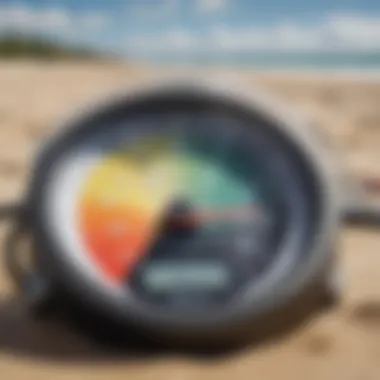
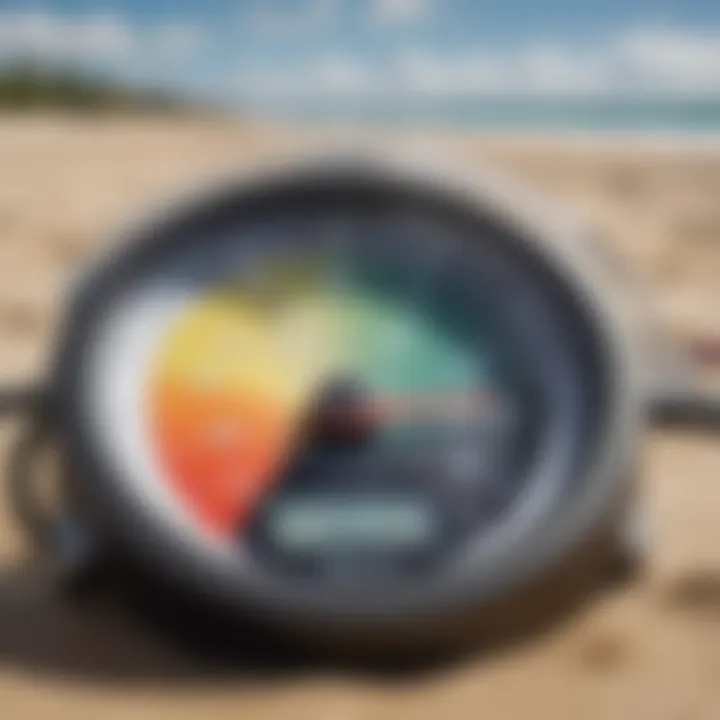
Thermal winds can vary but are generally reliable, making them an essential piece in the puzzle of wind forecasting.
Swell vs. Wind Waves
Understanding the distinction between swell and wind waves is essential for kitesurfers. While both phenomena can affect riding conditions, they arise from different sources and exhibit varied characteristics.
- Swell: Characterized by long, rolling waves that have traveled long distances from their origin, swell typically provides smooth rides with less turbulence. They often appear more organized and can create ideal conditions for kitesurfing.
- Wind Waves: These are shorter, choppier waves formed directly by local winds. They can create a rough ride and require different techniques to navigate effectively. Riding on wind waves can be a test of technique for even seasoned kitesurfers.
Both types of waves are dictated by the wind but understanding their characteristics helps in optimizing the riding experience.
Wind Forecasting Tools and Techniques
Wind forecasting tools and techniques are essential for anyone looking to enjoy kitesurfing. These tools help riders make informed decisions before heading out onto the water, ensuring they choose optimally windy conditions that not only enhance their experience but also minimize risks that can arise in unfavorable weather. Understanding various tools available can mean the difference between a thrilling ride and a potentially dangerous experience.
Meteorological Websites and Apps
The evolution of technology has undoubtedly changed how kitesurfers assess wind conditions. Websites and mobile applications dedicated to weather forecasting, such as Windy and Magicseaweed, play a significant role in this regard. These platforms provide real-time data on wind speed, direction, and other relevant metrics crucial for kitesurfers.
Here's how they can benefit you:
- Real-time Updates: They offer up-to-the-minute information on conditions, which is vital given that the weather can change faster than a hawk swooping down on its prey.
- Historical Data: Many of these tools give access to historical wind data, helping users identify patterns in wind behavior over time.
- User-friendly Interfaces: Designed to be intuitive, they often allow users to visualize data in a way that simplifies decision-making.
"Staying updated is imperative; a small oversight can lead to big troubles when you're harnessing the power of the wind."
Using Local Weather Stations
Apart from online tools, local weather stations provide a wealth of information specific to your kitesurfing location. They usually measure wind conditions in real-time, giving insights into both current and forecasted weather trends.
Some benefits include:
- Accuracy: Local stations often monitor microclimates specific to regions, which can dramatically differ from broader meteorological data.
- Additional Data: They typically provide complementary information like humidity levels, temperature, and pressure systems, which all contribute to overall wind conditions.
- Community Engagement: Many local stations involve community reporting and insights, fostering a culture of shared knowledge amongst local riders. This can be particularly useful for staying attuned to emerging weather patterns.
Anemometers: Measuring Wind Speed
An anemometer is a device that measures wind speed and direction. For kitesurfers, understanding how to use this handy tool can provide a considerable advantage. Whether on the beach or in a more remote area, knowing your wind speed allows for crucial preparation.
There are various types, including:
- Cup Anemometers: The classic three-cup design; easy to read but requires calibration.
- Vane Anemometers: These include a rotating vane, making them good for directional wind analysis.
- Digital Anemometers: Being portable and accurate, these are often preferred by serious kitesurfers for speed measurement.
Using an anemometer can help riders:
- Determine Safety Levels: Knowing the wind speed can indicate whether it’s safe to kite.
- Customize Equipment: Different wind strengths require different kite sizes; a quick check can influence gear choices.
Incorporating these tools into your pre-kitesurfing routine can significantly enhance both your enjoyment and safety on the water. Remember, having the right tools is just as important as understanding how to use them.
Interpreting Wind Forecasts
Understanding wind forecasts is indispensable for kitesurfers aiming to ensure safe and enjoyable experiences. The ability to interpret these forecasts empowers individuals to make informed decisions about their riding conditions. This section will dissect critical elements of wind forecasts, explaining how to gauge favorable wind conditions and what to be aware of while engaging with wind data.
Reading Wind Speed and Direction Charts
Wind speed and direction charts are akin to maps for kitesurfers. They reveal much about what can be expected when hitting the waves. To make sense of these charts, it is necessary to familiarize oneself with the symbols and scales used.
- Wind Speed: Usually expressed in knots or meters per second, speed is color-coded; lighter colors typically indicate calmer winds while darker shades suggest stronger gusts.
- Wind Direction: The arrows on these charts show where the wind is coming from. This is pivotal because the kite’s performance greatly relies on the wind direction relative to your position.
For example, a north wind will play out differently than a southeast wind. Knowing this can shape your plan for launching and riding. Understanding the nuances of these charts can turn messy weather into manageable riding conditions.
Understanding Wind Forecast Accuracy
A key factor in effective wind interpretation is understanding forecast accuracy. Forecasts can vary; thus, it is important to cross-reference multiple sources. Different meteorological services may use varying models to predict wind conditions, leading to discrepancies.
- Look for consistency across different forecasts. If several sources predict similar conditions, there's a good chance they are accurate.
- Pay attention to the update frequency. Wind conditions can change rapidly, and more regular updates typically mean more accurate forecasts.
As a kitesurfer, placing your trust in reputable forecasting models and reputable local sources can enhance your odds of a successful outing. Remember, not all forecasts are created equal; evaluating their reliability is crucial.
Common Forecasting Errors
Even the best meteorologists can misread the winds sometimes. Familiarizing yourself with common forecasting errors allows you to be prepared for surprises.
- Overestimating Wind Speeds: Sometimes forecasts paint a picture of more efficient winds than what actually arrives. Be alert that what looks good on paper may be less desirable on water.
- Ignoring Local Factors: Weather at a nearby station might not reflect what's happening directly at your favorite kitesurfing spot. Terrain, buildings, and coastal features can create microclimates that the forecasts might overlook.
- Timing Mismatches: Forecasts may indicate a favorable wind pattern but fail to account for local timing. Wind conditions can be fickle; delayed onset can disappoint.
"When in doubt, do additional research. Local knowledge is often the best-teller of hidden weather secrets!"
To stay ahead of the game, always double-check forecasts and consider local advice. Utilizing these insights can make the difference between a routine trip and an exhilarating day on the water.
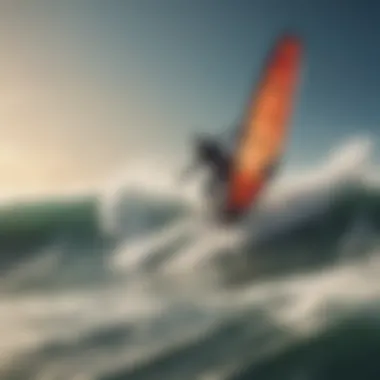
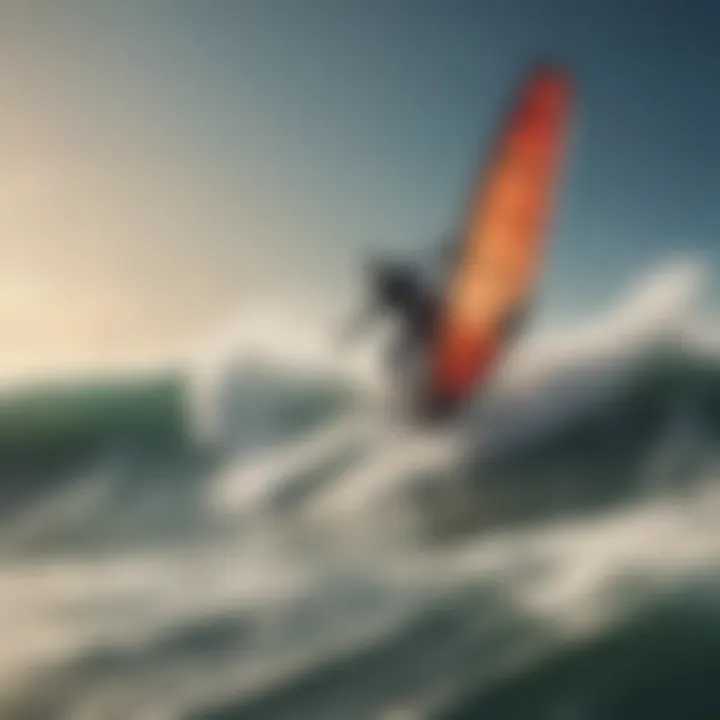
Effects of Wind Strength on Kitesurfing
Understanding the effects of wind strength is vital for kitesurfers at all skill levels. Wind can make the difference between a smooth ride and a harrowing experience. It's not just about the thrill; it's about safety, control, and knowing how to adapt to different conditions. Each wind strength category—light, moderate, and strong—comes with its own set of experiences and challenges, especially if you're trying to navigate your skills against the force of nature.
Light Winds and Beginner Options
When the wind is gentle, typically between 5 to 12 knots, it sets the stage for beginners to explore the water without excessive challenges. Light winds offer a perfect environment for new kitesurfers learning to balance, control their kite, and get a feel for the ride.
In such conditions, riders can use larger kites, which catch more wind and generate lift. The emphasis here is on safety and comfort. A few points to consider include:
- Longer Sessions: Light winds allow longer time on the water, ideal for beginners who need the practice.
- More Control: Larger kites make steering more manageable, reducing the likelihood of abrupt movements that can lead to falls.
- Focus on Technique: It’s easier to learn basic maneuvers in lighter winds; thus, beginners can hone their skills without feeling overwhelmed.
However, beginners should be cautious; even light winds can change rapidly, so it’s crucial to keep an eye on the forecast and local conditions.
Moderate Winds for Intermediate Levels
As kitesurfers progress, they often seek moderate winds, which range from 12 to 25 knots. This wind strength creates more dynamic conditions, allowing for exciting rides filled with jumps and tricks. Intermediates can refine their skills and build confidence under these conditions.
Here are key takeaways regarding moderate winds:
- Diverse Techniques: Riders can experiment with various tricks and techniques like jumping and carving without compromising control.
- Optimal Kites: Most intermediate kiters prefer using medium-sized kites that balance power and maneuverability. It’s important to know the right kite size for varying wind speeds.
- Evaluate Conditions: Skill level, experience, and physical condition play a critical role in how much wind is suitable. A well-versed kiter should constantly assess conditions, being ready to adjust their approach as needed.
Strong Winds and Safety Considerations
Conversely, winds exceeding 25 knots often signify that a kitesurfing session may quickly turn into a test of skill. Strong winds offer plenty of thrill but pose serious risks, especially for less experienced riders. Navigating in these conditions requires heightened safety awareness.
Important considerations for kitesurfers facing strong winds include:
- Choosing the Right Equipment: Smaller kites are essential to manage the increased power, as larger kites can become unwieldy.
- Physical Fitness: The ability to control the kite in turbulent conditions demands higher fitness levels; it is crucial to know your limits.
- Know When to Call It: Sometimes, the conditions aren’t suitable, and it’s crucial to have a mindset to postpone or skip fun sessions when the wind is too strong.
"Understanding how to read the wind not only enhances your riding experience but can also save your life."
In summary, the strength of the wind can drastically change the kitesurfing experience. Whether you’re a beginner needing gentle breezes to learn or an intermediate looking to push your limits, or even an experienced surfer skillfully navigating strong conditions, knowledge about wind strength is fundamental for safety and performance.
Environmental Factors Affecting Wind Forecasts
Understanding the influence of environmental factors on wind forecasts is essential for any kitesurfer, whether you are a novice or a seasoned rider. The interplay of various elements, including coastal geography, seasonal changes, and local temperature pressures, can substantially alter wind conditions at any given time. By grasping these influences, surfers can make better decisions about when and where to ride, ultimately enhancing their experience and safety on the water.
Coastal Geography and Wind Patterns
Coastal geography plays a pivotal role in shaping wind patterns. The layout of the coast—whether it's rocky cliffs, sandy beaches, or marshy wetlands—can create unique wind conditions that vary dramatically from one spot to another. For instance, when winds blow from the ocean towards the shore, they can be funneled by geographic features such as hills or valleys, accelerating the wind speed in specific areas. In contrast, sheltered spots may experience significantly lighter winds, making them less favorable for kitesurfing.
- Wind Shadows: Areas behind tall cliffs or buildings can create wind shadows, decreasing wind intensity. This is essential to recognize before deciding to launch your kite.
- Tempestuous Bays: In some coastal areas, wind patterns change rapidly due to shifting tides. This can lead to unexpected gusts that catch kitesurfers off-guard.
Understanding these features not only aids in selecting the right spot to ride but it also raises awareness of the types of challenges one may face due to local geography.
Seasonal Variations in Wind Conditions
Seasons bring about profound shifts in wind patterns, which directly impact kitesurfing conditions. During summer, thermal winds often dominate coastal areas, resulting in predictable afternoon breezes—ideal for kitesurfing enthusiasts. During this time, the sun heats the land faster than the water, causing air to rise quickly and fill in with cooler air from the sea, creating those pleasant winds. Conversely, fall and winter may bring stronger winds due to frontal systems and storms, but these winds can be more unpredictable.
- Summer: Gentle to moderate winds, ideal for beginners and leisurely rides.
- Winter: Stronger and gustier winds, suitable for advanced kitesurfers, but also fraught with increased safety risks.
These seasonal changes are significant; they affect not only the type of gear you might need but also the safety measures necessary when hitting the waves.
Impact of Temperature and Pressure Systems
Temperature and pressure systems exert a strong influence on wind behaviour. High and low-pressure systems create wind patterns that can vastly differ from calm to turbulent conditions. For instance, low-pressure areas generally bring in winds that are gusty and changeable, while high-pressure zones often lead to more stable wind conditions.
"Understanding pressure and temperature trends can serve as your early warning system—your guide to good or bad rides."
- Cold Fronts: These can introduce strong, abrupt winds from different directions, which might be challenging for kitesurfers to navigate.
- Warm Fronts: Usually bring in lighter winds but can result in prolonged periods of calmness, leading to downtime unless you're prepared to adapt.
Being aware of these factors allows kitesurfers to anticipate and plan for the expected wind conditions, promoting a safer and more enjoyable experience.
Safety Guidelines for Kitesurfers
In the world of kitesurfing, safety isn't just an afterthought; it’s at the heart of every thrilling ride. Understanding and adhering to safety guidelines can mean the difference between an exhilarating experience and a dangerous situation. When kitesurfers familiarize themselves with proper assessments of wind conditions, recognize unsafe patterns, and are prepared with emergency protocols, they not only enhance their safety but also the enjoyment of the sport for everyone involved. This segment aims to provide essential guidelines that kitesurfers should follow to keep themselves safe while experiencing the thrills that come with this dynamic water sport.
Assessing Wind Conditions Before Launching
Before stepping onto the water, kitesurfers must take a moment to assess the wind conditions rigorously. This isn’t just a quick glance at the flags fluttering on the beach; a detailed understanding can dramatically boost safety. Here are key aspects to consider:
- Wind Direction: Knowing where the wind is coming from is critical. A side or onshore wind can create a much safer environment compared to an offshore wind, which can carry a kitesurfer away from safety.
- Wind Speed: Utilize wind indicators or apps to gauge the wind speed. Ideally, light breezes of 10-15 knots are suitable for beginners, while experienced riders might prefer stronger winds. Always stick to your skill level regarding wind strength.
- Local Variability: Local structures, like buildings or trees, can affect wind flow. Always be on the lookout for areas where wind speed might fluctuate.
- Tides & Current: Wind isn’t everything; understanding water conditions is also crucial. Pay attention to tides and currents, as they can augment or mitigate wind effects.
This pre-launch assessment empowers kitesurfers to ensure they only hit the water when conditions are favorable, minimizing risks.


Recognizing Unsafe Wind Patterns
Not all winds are created equal, and some can be downright treacherous for kitesurfing. It’s vital for kitesurfers to hve the ability to identify these unsafe wind patterns:
- Shifty Winds: Winds that change direction suddenly can be a nightmare. They create unpredictable conditions, making control difficult. If the wind pick up or it turns unpredictable, consider calling it a day.
- Gusty Winds: Wind that fluctuates between calm and strong bursts poses a serious challenge. These gusts can catch both beginners and seasoned riders off guard, leading to potential accidents, with kites either being overpowered or not catching enough wind.
- Storm Indicators: If you see dark clouds starting to gather, or the wind starts to howl, it’s time to head back to shore. Storms can develop rapidly, and strong winds can appear out of nowhere, bringing dangerous conditions.
Kitesurfers must stay vigilant and understand when to recognize that the conditions are no longer safe for riding.
Emergency Protocols for Strong Winds
Despite all precautions, there are moments where strong winds catch you off guard. Having established emergency protocols can help mitigate dangers:
- Know Your Escape Routes: Always have a plan in mind for getting back to shore quickly if conditions become untenable. Familiarize yourself with the layout of the beach and any nearby structures.
- Practice Quick Depowering: Riders should be equipped with techniques for quickly depowering the kite. This involves adjusting lines and managing the kite to reduce lift and regain control.
- Join the Buddy System: Never kitesurf alone. Always have a buddy who is aware of your riding plans. This way, they can help if trouble arises, or vice versa.
- Carry Safety Equipment: A quick-release mechanism and safety knife can be life-savers in critical situations. Ensure that your gear is well maintained and easily accessible.
"When in doubt, don’t head out. It’s better to miss a great day than to risk safety."
By understanding and implementing these emergency protocols, kitesurfers can respond effectively when conditions turn against them.
Techniques for Wind Adaptation in Kitesurfing
Wind is a fickle companion, often changing unpredictably, making it imperative for kitesurfers to master techniques for adapting to its whims. Understanding these techniques not only enhances your enjoyment but also ensures your safety while riding. Being able to adjust to different wind conditions can transform any unfortunate wind situation into an exhilarating experience. Here we will explore key aspects of adjusting kite settings, riding techniques for various strengths, and the benefits derived from learning from seasoned kitesurfers.
Adjusting Kite Settings for Wind Variability
When faced with changing wind conditions, knowing how to adjust kite settings is crucial. Kite tuning can influence performance significantly. Heightened sensitivity in lighter winds leads to graceful navigation, while robust settings may be needed for strong gusts to avoid being overpowered.
- Depower Settings: Ensure your kite has the right depower settings. In strong winds, increasing depower can prevent loss of control. This often involves shifting the trim strap or adjusting the angle of attack on your kite.
- Kite Size: Choosing the right kite size is vital. A smaller kite can help manage strong winds, while bigger kites excel in lighter conditions. Understanding your own weight and skill level in reference to kite size is key.
Example: A rider weighing 75 kg may use a 9m kite on a sunny day with lighter winds, but would switch to a 7m kite when the winds unexpectedly pick up, preventing excessive pull and ensuring safety.
Adjusting your setup elegantly to match wind changes can turn an average session into a memorable one.
Riding Techniques for Different Wind Strengths
The technique you employ while kitesurfing can vary enormously, depending on the wind’s strength. Knowing how to adjust your riding style ensures that you remain in control and capitalize on the wind’s potential, irrespective of its intensity.
In light winds, riders need to focus on keeping the kite low and accelerating smoothly to generate speed.
- Important Techniques:
- Glide and Pump: In lighter winds, pumping the kite helps to generate power. Allow the kite to fly, while moving your weight over your toes helps maintain speed.
- Edge Control: Keep your weight distributed correctly to maintain balance while allowing the kite to catch more wind.
As the wind intensifies, shift your approach:
- Lower Your Center of Gravity: Stance wide and low helps absorb the chop while maintaining control
- Use Your Body: Lean back against the pull to maintain balance. This is particularly important when gusts try to pull you off balance.
Learning from Experienced Kitesurfers
Gleaning insight from seasoned kitesurfers is invaluable. They possess a wealth of knowledge and practical tips that are often not found in books or articles. Here are some approaches to enhance your learning:
- Mentorship: Seek out experienced kitesurfers who can share their insights firsthand. Watching experts navigate tricky conditions can provide valuable lessons on sail management and body positioning.
- Participate in Community Forums: Engaging in platforms like Reddit can lead to discussions about personal experiences and challenges faced while kitesurfing in various wind conditions. This shared knowledge can help you anticipate and adapt to similar situations in your riding.
- Workshops and Clinics: Take part in workshops hosted by skilled practitioners. Not only do they offer demonstrations, but they also facilitate interaction that can deepen your understanding of adapting to wind conditions.
Learning from those who have spent countless hours navigating the tensions of the wind can impart skills that unravel the complexities of this sport, leading to richer kitesurfing experiences.
Important Note: Always ensure you have a reliable weather forecast before embarking on your kitesurfing adventure. Familiarize yourself with local conditions for both safety and enjoyment.
The Future of Wind Forecasting in Kitesurfing
As kitesurfing continues to grow in popularity, the need for precise and reliable wind forecasting becomes not just significant, but paramount. The future of wind forecasting in this sport holds promise for enhancing safety and maximizing the overall riding experience. With rapid advancements in technology and methodologies, kitesurfers can expect a more nuanced understanding of wind conditions that affect their days on the water. As we look forward, several factors will influence how kitesurfers utilize wind forecasts.
Advancements in Meteorological Technology
The landscape of meteorology is undergoing transformative changes thanks to innovative technology. Modern tools provide more accurate readings of wind patterns, helping kitesurfers interpret conditions better than ever before. For instance, high-resolution weather models, once limited in scope, now capture fine details of local phenomena. Technologies such as Doppler radar and LiDAR allow for real-time tracking of wind changes. These advancements reduce uncertainties and equip riders with timely information.
Additionally, personal weather stations have surged in popularity. These devices, when strategically placed, offer hyper-local forecasts. When combined with mobile applications, users can receive instant updates about shifting wind conditions at their favorite spots.
Crowdsourced Reporting for Local Forecasts
Crowdsourcing information can be a game changer in local wind forecasting. Platforms where kitesurfers share real-time observations allow for a communal effort in gathering vital data. Imagine checking a platform and finding not just numerical values for wind speed but also anecdotal reports like, "It’s picking up by the pier!" This localized knowledge enhances forecasting efforts and creates a vibrant community of informed riders.
The application of social media and forums is also pivotal for gathering insights from kitesurfers who share their experiences. With a little bit of initiative, gathering localized wind reports can help kitesurfers avoid disappointment when conditions don't meet expectations. A group of friends can even create a mini network, reporting back on wind conditions as they ride.
The Role of AI in Weather Predictions
Artificial Intelligence (AI) has found its niche in weather forecasting, offering a breadth of possibilities for kitesurfing enthusiasts. By analyzing vast amounts of meteorological data, AI systems can identify patterns and predict changes with remarkable accuracy. So imagine having an app that utilizes machine learning to assess past wind behavior and anticipate what might happen next.
Moreover, predictive analytics can empower riders with forecasts that account for numerous variables—such as temperature fluctuations, impending storms, and the influence of local geography—all in real time. A well-calibrated AI-driven model can refine expectations, offering insights like when the wind might peak or drop, thus making for a smoother riding experience.
"In this evolving landscape, the combined forces of technology, community input, and AI make for unprecedented opportunities for kitesurfers to harness the wind with confidence and safety."
As we peer into the future, the integration of these cutting-edge methods and technologies unveils a path for kitesurfers not only to enjoy their rides but to do so with a higher degree of safety and knowledge. Staying informed about these advancements can provide kitesurfers—be they newcomers or seasoned veterans—an edge that enhances both enjoyment and understanding of conditions each time they hit the water.















